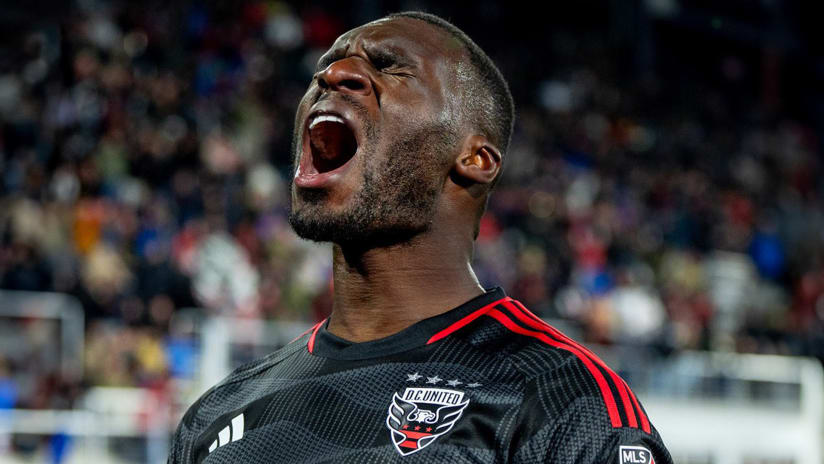I'm going to save the "fitness" talk for last. Because we know that's what people are going to bring up in the wake of yet another late collapse from the USMNT, this time in a 3-2 loss at Denmark.
Here are three things to take away from a performance that ranged from ugly to opportunistic and back again:
1. You are who you pretend to be
Do they hoof the ball because of the way they're set up? Or are they set up that way because they're only really able to hoof the ball when facing quality competition?
I think that's a false dichotomy, as well as an incorrect portrait of how the US have generally played. Being a good transition and counterattacking team is not ipso facto proof that you are a hoof-and-hope, Route 1 team. Building around the ethos of "run fast, try hard" does not automatically rule out "play smart" as part of the gameplan (look at who's No. 2 on THIS list).
But for lots of folks out there, the perception is that the US have always played hoof-and-hope, and I will admit that even in the best of times under Bob Bradley and Bruce Arena, the US were often direct enough to make the inexperienced or agenda-driven observer say "Damn, we can't hold onto the ball."
It's an issue that has not disappeared in Jurgen Klinsmann's three-and-a-half years in charge:
I don't hold it against Klinsmann that we are a direct, reactive team – a scenario that was always going to be exacerbated when playing a flattish 4-4-2 against a technical 4-3-3 side, even if the pitch was more like a dirt parking lot. We are who we've always been, and that's fine.
My big problem is that there's been a regression in this group's ability to play from the back. This was especially evident in Aarhus on Wednesday, but before you go writing it off as just a friendly, remember these numbers (courtesy of Opta) from the World Cup:
U.S.A |
|||||
Year |
Minutes Played |
Possession |
Passes Per 90 |
Passes, Final Third Per 90 |
Shots Per 90 |
1990 |
270 |
46.61% |
324.33 |
90 |
11 |
1994 |
360 |
42.61% |
352 |
89.75 |
11.5 |
1998 |
270 |
53.83% |
452.67 |
157 |
16.67 |
2002 |
450 |
48.59% |
356.4 |
126.8 |
12.6 |
2006 |
270 |
50.31% |
392 |
133.33 |
10.33 |
2010 |
390 |
49.06% |
367.85 |
122.77 |
15.46 |
2014 |
390 |
43.48% |
381.69 |
98.54 |
10.15 |
Opponents |
|||||
Year |
Minutes Played |
Possession |
Passes Per 90 |
Passes, Final Third Per 90 |
Shots Per 90 |
1990 |
270 |
53.39% |
365.33 |
131.33 |
19.33 |
1994 |
360 |
56.93% |
487.5 |
149.25 |
17.75 |
1998 |
270 |
46.07% |
391.67 |
117.67 |
13 |
2002 |
450 |
51.66% |
295.8 |
119.4 |
16.2 |
2006 |
270 |
49.92% |
392.33 |
120 |
10.33 |
2010 |
390 |
50.94% |
375.46 |
123.92 |
14.08 |
2014 |
390 |
56.52% |
500.08 |
168.23 |
21.69 |
Awful in possession for the purposes of chance generation, and awful in in possession to the purpose of killing off a lead.
And especially awful at playing out of the back, with 29 misplayed passes originating in the US defensive third tonight:

That's right in line with what we did in Brazil. It doesn't matter the stakes, the opponent, or the personnel: The US under Klinsmann are more direct and have fewer ideas in possession than at any time over the last two decades.
2. Bedoya, Bradley & midfield promise
Alejandro Bedoya came in for what I thought was some undeserved stick on Twitter because of Denmark's dominance in possession and his own lack of forward push. But I actually thought he did a pretty damn good job of partnering Michael Bradley as the two held their own despite being outmanned 3-2 in the center of the park in the first half.
You could see Denmark trying to probe centrally, but Bedoya was quick and decisive in his movements, and allowed Bradley to push higher both with and without the ball. This is why I called it a "flattish" 4-4-2 instead of just a "flat" 4-4-2. If anything it looked much more like the Y midfield we've seen LA run in recent years under Bruce Arena, with Bradley stacked on top of Bedoya.
And understand: we want Bradley to push higher than his central midfield partner. What we don't want is for him to be a pure No. 10, a pseudo trequartista who operates underneath a lone striker (which is how Klinsmann used him in the World Cup). When given a midfield partner who provides defensive solidity, and then a couple of runners to pick out up top, stuff like this happens:
That goal above happened after Bedoya was subbed for Alfredo Morales, but the principle is the same. I've written about Bradley's playmaking prowess from that spot a million times, and maintain that it's the skillset the US should be built around.
The problem, then, wasn't Bedoya or Morales. The issue was that the US wingers were poor in their defensive discipline, awareness and tracking, that the backline was disorganized, and that the fullbacks kept losing individual battles:
The chances out of the above mess aren't the fault of Bedoya, who was primarily concerned with preventing a direct pass into Zone 14. This was a team breakdown – same as the first Danish goal – compounded by an individual breakdown on the flanks.
If you're playing a 4-4-2 against a 4-3-3, by definition you're conceding the center of the pitch. That means you'd damn well better get dangerous on the flanks.
In this one, the US never even came close to winning that battle.
3. Fitness & flatness
One of the interesting features of this game was how the US played in two distinct blocks for much of it. They poured on high pressure, especially in the first half, and definitely gave the Danish defense a case of the yips (Bedoya's positional discipline allowed Bradley to be very effective in conducting that high press, by the way). I thought it was mostly a smart, tone-setting move.
When Denmark broke through the high press, then the US would abandon the mid-level and drop into a pure, reactive low block. All high or all low, and no in between.
There aren't a ton of teams that play like this (in MLS, New England are the only one) and it's the first time I've really seen it done under Klinsmann. So I'm willing to write off many of the mistakes that we saw for the game's first 75 minutes.
However, the same problem keeps coming up in the last 10 or 15: the US lines in midfield and defense either compress too early, or get disconnected enough to leave huge swaths of space in the event of a turnover.
Trigger warning: THIS is the breakdown of the goal the US conceded at the death vs. Portugal last summer. Watch it.
And now watch Lord Bendtner's game-winner today:
That's not a fitness issue in the backline, that's a confusion issue. It's a discconection issue. On the second goal, it was a flatness issue. The US just invites Denmark forward by not putting any coordinated pressure on at the midfield stripe.
I don't care that we lost a friendly. I care that we keep losing in the same ways that we lose the games that matter, with no end in sight.
Nothing is uglier than that.













